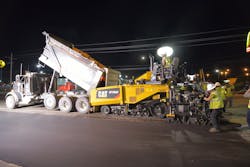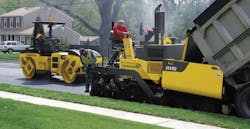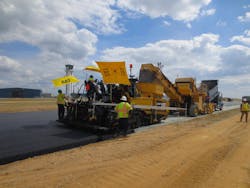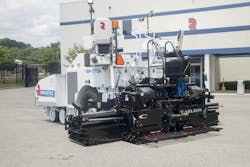Products and Prospects for Asphalt Paving
Now that the FAST Act (Fixing America’s Surface Transportation Act) has been in effect for more than 18 months, is it having an effect on the asphalt paving equipment industry?
“The short answer is ‘yes,’” says John Mooney, paver product manager, Volvo Construction Equipment. “The FAST Act is driving a positive attitude in the market that has been suppressed for years. As confidence returns to the market, paver demand should continue to grow.”
Caterpillar’s Jon Anderson, global sales consultant, agrees. “The FAST Act gives contractors confidence to invest in equipment. The passage of an incremental infrastructure bill would also have a big effect on the market.”
Roadtec’s Kyle Neisen, product manager, pavers & MTVs, is of like mind. “Thanks to the 2015 FAST Act and the current focus on improving [the country’s] infrastructure, we have high hopes for the U.S. paver market.”
“The FAST Act has had a positive impact on the highway-class market, as long-term, dedicated transportation spending is bringing greater certainty to the marketplace,” says Travis Colwell, marketing and communications coordinator, Carlson Paving Products. “With the FAST Act, projects are now more certain to be completed, allowing contractors to invest in new machines and technologies. Also, a sizeable number of states are increasing infrastructure spending through raising gas taxes and other revenue measures, adding to the positive and robust trend we are seeing within the highway-class market.”
Jim Holland, vice president, Vögele (Wirtgen Group), also says he new funding has improved prospects for the asphalt pavers industry, but adds a caution.
“More important than the slightly higher funding levels the FAST Act provides is the longer-term confidence the five-year duration of the bill provides both contractors and their state-agency customers. Contractors and agencies can plan projects for the long term, rather than lurch between six-month extensions. But the bill expires in little more than three years, so we have work to do in getting a bill that will serve well beyond 2020. Long term, we must enhance revenues for surface transportation, [because] existing revenue streams are inadequate to support the funding authorized by the FAST Act.”
Challenges remain
While the asphalt-paving industry might be breathing somewhat easier with a reliable funding package in place, paving contractors are still confronted with tough issues.
“Challenges are abundant for every customer we work with,” says Roadtec’s Neisen. “While each operation seems to have its unique challenges, a common concern we’re hearing more frequently is difficulty finding—and keeping—a good crew.”
Volvo’s Mooney also sees an aging workforce as an increasing liability for paving contractors, a situation calling for paving machines that are easier to operate and easier to maintain, with controls that reduce the amount of handwork required of the crew. Also, he says, contractors are being challenged by material formulas that are significantly different than in the past, again calling for machines that facilitate the crew’s efforts to place a smooth mat.
“Attracting and keeping skilled employees is the biggest concern we hear from contractors,” says Caterpillar’s Anderson. “Training and easy-to-use machines are investments that contractors must make in employees—tangible signs that the contractor is willing to provide employees the tools and know-how they need to promote success and develop careers. That investment reassures the crew, helps maximize skills, and fosters a sense of pride and confidence.”
Bill Rieken, BOMAG paver applications specialist, reinforces the consensus.
“On the operations side,” says Rieken, “experienced paving crews are retiring at a rapid pace, and some companies are challenged to find replacements for machine operators, crew members, and service technicians who might have been in the contractor’s employ for 20 years or more. Quality training programs for less-experienced replacements has to be a nonstop process and will be of growing importance as more companies lose long-term employees to retirement.”
On the paving side, says Rieken, “meeting more stringent temperature-differential specifications across the mat serve as a growing challenge for contractors.” More states are implementing (or considering implementing) bonus structures tied to the mat’s temperature uniformity, he says, which “is the foundation for meeting compaction specifications to improve road longevity.” Paving machines that are designed to combat thermal segregation will assist in this regard, he says.
Also on the paving side, says Carlson’s Colwell, is a diminishing reliance on full replacement of roadways and greater reliance on preservations overlays, creating challenges for machines that are more adapted for thicker lifts and full-roadway replacement. Contractors also are facing increased emphasis by state DOTs to improve mat quality and joint density, he says, with more stringent specifications for smoothness, density, and mat uniformity.
“Manufacturers, however, are introducing new technologies, attachments, and platforms to give contractors the tools to meet these existing and emerging challenges,” says Colwell. “These include, for example, specialized screed attachments that improve density figures at the longitudinal joint and screed platforms adept at thin lift paving applications.”
Advice for paver buyers
Construction Equipment asked a number of manufacturers if they had any buying cautions to pass along to potential customers, recognizing, of course, that contractors who buy paving machinery are pretty savvy about what they need.
“First, resist the temptation to buy on price,” says BOMAG’s Rieken. “With proper preventive maintenance, these machines are designed to give more than 10 years of reliable service. Work with manufacturers to get a clear picture of total ownership costs. Pay special attention to wear items, such as slat drive chains, slat bars, and conveyor floor liners—make sure they’re designed to give years of service without replacement and have a strong warranty. Make sure, also, that rubber tracks are warranted for at least three years or 3,000 hours, because frequent replacement can drive up operating costs.”
“Consider the total cost of ownership when purchasing a machine,” says Caterpillar’s Anderson. “This includes not just the purchase price, but also owning and operating costs, as well as resale value.”
Also in the interest of providing a high-quality mat, Vögele’s Holland suggests that buyers investigate the design of a machine’s feeder system to ensure that it can deliver material in a consistent manner. On track pavers, he says, the machine’s ability to maintain straight-line travel is critical for smoothness and joint quality, as are features designed to keep the screed in balance during fast stops and starts. He says also that onboard diagnostic capability is of significant benefit—providing the ability to troubleshoot electrical problems without the need to bring additional equipment onboard, such as a laptop.
Prospective buyers of commercial pavers should consider the return on investment of the platform and the screed, says Carlson’s Colwell. Look primarily at the machine’s cost of operation per hour, he says, taking into account the longevity of wear components and the platform itself. Then, look closely at the screed, including ease of adjustment, heating source, ability to level, and its ability to produce a quality mat.
Volvo’s Mooney steps back a bit from the purchase decision and reminds buyers of a fundamental principle. “The paver purchase is a big investment, and putting a crew together is an even bigger investment—so, winning a bid on a job takes controlled risk. Making the best equipment selection should not be risky. Always go into business with a manufacturer and a dealer that can be trusted to be there through the machine’s long life.”



